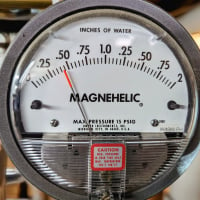Best Of
Re: Are people actually saving significant money with pellet stoves?
Nah it was from a commonly shared fake article, it fooled a ton of facebook users since most people don't really understand how any of this works, and those that do would definitely believe a tech billionaire who oversells their product might oversell a new product. It's still funny though imo
here is a link to the original, and again this article is 100% fake news he never said any of this stuff lol
https://web.archive.org/web/20240109175335/https://cosmoheater.store/
Re: Is this Air Admittance Valve Installed Correctly?
Does that sink have an overflow and what kind of drain is it. I.E. do you use a lever, or knob to close the drain, or is it one of the ones you push down on the top of the drain to close it?
Every bathroom sink I've seen that does not have an overflow drains horribly. The AAV is there to stop you from siphoning the trap out and is nothing more than a vacuum breaker. The AAV would never assist in draining.
 ChrisJ
ChrisJ
Re: Beckett CG4 Gas burner ... replace QB-180
This will work. We've done it. But don't think you can DIY this- you need a pro to install and set it up properly.
Re: My first boiler install, so far
Thanks @Larry Weingarten. I already have your book on water heaters btw.
Re: New Boiler - Radiator Screaming
You need to fix the near boiler piping. By doing what he is doing is just praying he gets the whistling down to an acceptable level to which you will agree to. Even if he can satisfy you by doing what he is doing You will still going to have high fuel bills. there is no way around it. Basements with steam boilers are always warm even insulated but having copper piping on your boiler is only going to increase the heat into the basement. Never mind the wet steam its going to generate.
And considering the manufacturer and there castings issues i would definitely get the piping changed. I don't know how anybody else feels but i wouldn't service this boiler or any boiler unless the near boiler piping was properly installed. I don't need a customer blaming me for some noise or leak that was happening before I got there but they didn't notice it until after i worked on it. I've done enough PM's on Burnham's that the first thing i do is flood them.
Re: New Boiler - Radiator Screaming
I think it's also useful for the OP to understand, steam, when running properly, should be silent. You shouldn't hear a bang, creak, groan, nothing but warmth. I'd say at most maybe a hair of air "noise" from a vent, but it would be at the level that you'd have to catch it in the act and listen carefully, not screaming as they state.
I think steam gets a bad reputation as making noise in some way. I think it's valuable for the OP to understand what the expectation is, and that is essentially, silence.
Re: New Boiler - Radiator Screaming
Piping is horrible. No two ways about it. Maybe try to get the manufacturer involved
Re: New Boiler - Radiator Screaming
For me, he’s either BSing, or just doesn’t know. I question the knowledge when they can’t size it correctly. There are generous factors built into those rating to cover piping. A properly sized IN4 has enough factor for 140’ of 2” piping. I’m going to guess you don’t have close to that. With the IN6, it’s hundreds of feet. Are you planning on adding an addition to the house and expand the system? If not the additional radiators comment makes no sense. Also made me chuckle, like he’s making future plans for your house, on your behalf.
One step at a time makes no sense. The piping is wrong, it’s not really a discussion topic, there’s a picture in the manual showing what’s correct and that isn’t it. So is this like trial piping and he’s going to rip it out and do it over as part of the process? That wouldn’t make sense at all.
I would also suggest you contact Burnham about them disconnecting 2 burners. That very likely will void the warranty for the boiler if the contractor didn’t get their approval for it. To be very clear on this comment, you contact Burnham, I wouldn’t take the contractors word for it.
My assessment, they are doing a few things to cover up until you go away out of frustration. And yes, I’m sure they are being super nice while they are doing it. Nice won’t make it work.
This lack of knowledge in my area is why I ended up replacing my own boiler, I just had zero confidence in any of the local contractors.
I wish you luck.
